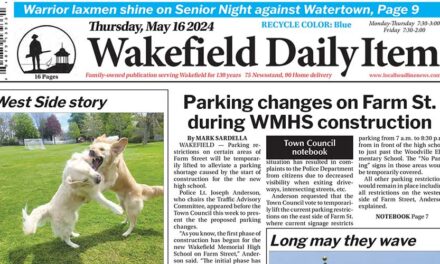Published October 29, 2019
By MARK SARDELLA
WAKEFIELD – As has been the practice at tax classification hearings in Wakefield for many years, the Town Council last night voted unanimously to select the maximum allowable shift factor, thereby shifting more of the property tax burden onto commercial properties and affording residential taxpayers the lowest share of the tax burden allowed under state law.
They also went further and decided to forego the full 2.5 percent tax levy increase allowed by law. They voted to apply an additional $400,000 from Free Cash to lower the tax levy total and offer some further tax relief to residents. That vote, however, was not unanimous, passing by a slim 4-3 margin.
Director of Assessments Victor Santaniello was on hand for last night’s Tax Classification hearing, as was Assessor Brian Donegan. The other two members of the Board of Assessors, Sebastian Tine and Jane D’Addario, were unable to attend last night, Santaniello explained.
He noted that four votes were required by the Town Council:
• Selection of a Minimum Residential Factor.
• Selection of an Open Space Discount.
• Granting of a Residential Exemption.
• Granting of a Small Commercial Exemption.
He noted that selecting Residential Factor of 1 would yield a single tax rate of $14.31 per $1,000 of value (residential and commercial). However, he reminded the board that state law allows municipalities to select a factor less than 1, thereby shifting more of the tax burden onto the Commercial/Industrial/Personal (CIP) classes of properties. Historically, he noted, Wakefield has chosen the maximum allowable shift factor to afford residential tax payers the lowest share of the tax burden allowed by state law.
Assuming the maximum allowable tax levy increase of 2.5 percent, that would mean a residential tax rate of 12.83 per $1,000 of valuation and a CIP rate of $25.04 per $1,000 of valuation.
The average single-family home value in Wakefield is $555,900, Santaniello said. Selecting the maximum allowable shift saves the average residential taxpayer $823 compared to not selecting the maximum shift.
Still assuming the full 2.5 percent tax levy, selecting the maximum shift would result an average annual residential tax bill of $7,132 ($355 or 5.35 percent more than last year).
For the average commercial property valued at $1,353,600, the annual tax bill would be $33,894 ($892 or 2.7 percent more than last year).
However, Chairman Edward Dombroski asked Santaniello to run the numbers for a scenario where an additional $400,000 from Free Cash was used to lower the total tax levy.
In that case, Santaniello said, the residential tax rate would drop to $12.77 per $1,000 of value, saving the average homeowner an additional $33.35 for the year. The CIP rate would drop to $24.88 for an additional savings of $175.97 on the annual commercial tax bill.
Dombroski argued that the town is in a strong financial position and giving the taxpayers a measure of additional relief would not impact the town budget.
In response to a question, Maio said that the town currently has about $8.6 million in Free Cash. About $3.5 million from free cash would be required to balance the budget at the full 2.5 percent tax levy increase. Adding another $400,000 would leave about 4.5 million in Free Cash he said. But based on anticipated revenues, the town would still end up with about $7 million in Free Cash at the end of the year, in keeping with the town’s financial policies.
Town Councilor Mehreen Butt was concerned that reducing the amount in the Free Cash account could hurt the town’s AAA bond rating when borrowing for large capital projects. But Maio said that was not likely to happen.
Councilor Jonathan Chines argued in favor of raising the tax levy by the full amount. He was worried about future needs like addressing deficiencies at the high school, the Public Safety Building and the Public Works Facility. He warned that the good fiscal times would not last forever
Town Councilor Ann Santos said that she was torn on the issue. She said that for most homeowners an additional $33 would be little more than symbolic. But she also felt that it was important symbolism in that it that signals to the taxpayers that the town will not go to the maximum tax levy if it doesn’t have to.
Councilor Peter May agreed with Santos that the symbolism was important. He brought up the name of former Selectman Phyllis Hull.
“Phyllis world say, ‘If you don’t have to take 2½ percent, don’t do it,’” May insisted.
Dombroski pointed out that Free Cash would not be a factor in funding large projects like the high school or the Public Safety Building.
“We are in strong financial position before and would be in a strong position after,” he said. “It’s the taxpayers’ money that we can give back to the taxpayers. If not now, when?”
Ultimately, the Town Council voted to use an additional $400,000 from free cash in order to avoid going up the full 2.5 percent. That means that the residential property tax rate will be $12.77, saving the average homeowner an additional $33.35. The CIP rate will be $24.88 for a savings of $175.97 on the average commercial tax bill.
Councilors Dombroski, May, Santos and Paul DiNocco voted in favor of granting the additional tax relief. Butt, Chines and Julie Smith-Galvin were opposed.
The other votes taken at last night’s Tax Classification hearing were routine.
The Town Council voted not to offer the open space discount. Santaniello pointed out that the Town has never voted a discount for open space since no properties have been identified which fulfill the legal requirements.
Regarding the residential exemption, Santaniello pointed out that an exemption up to 35 percent of average residential value is allowable. However, it has only been adopted in a handful of communities including Boston, Cambridge, Chelsea and Brookline.
In Wakefield, he said, approximately 30 percent of homeowners would end up shouldering the burden as most homes in Wakefield are owner occupied.
The town Council voted not to offer the residential exemption.
Santaniello said that the Assessing Department is unaware of any business meeting the legal requirements for the small commercial exemption. The Board voted not to adopt the measure.




